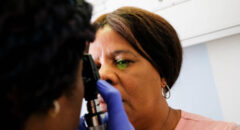
Thyroid eye disease (TED), also known as Graves’ orbitopathy, is a rare but serious condition that affects the eyes. It often occurs in individuals with hyperthyroidism, particularly in people with Graves’ disease, but it can also present in those with normal or low thyroid hormone levels. As TED impacts the tissues around the eyes, it can lead to a range of uncomfortable and sometimes debilitating symptoms. Here are the key questions you should ask your doctor or healthcare provider if you or a loved one is facing thyroid eye disease.
1. What exactly is thyroid eye disease, and how is it related to thyroid function?
Thyroid eye disease occurs when the immune system mistakenly attacks the muscles and other tissues around the eyes, causing inflammation and swelling. While TED is most commonly associated with Graves’ disease, an autoimmune disorder that affects the thyroid gland, it can occur in patients with other thyroid conditions or even in those with no thyroid abnormalities. Understanding the link between your thyroid health and TED is essential to managing both conditions effectively.
2. What are the symptoms of thyroid eye disease?
TED symptoms can range from mild to severe and often include:
- Dry or gritty feeling in the eyes
- Redness and swelling
- Bulging eyes (proptosis)
- Sensitivity to light
- Blurred or double vision
- Eye pain or pressure
- Difficulty closing your eyes fully Recognizing these symptoms early is crucial for receiving timely care and preventing long-term damage.
3. How is thyroid eye disease diagnosed?
Diagnosis often starts with a clinical examination. Your doctor may observe the appearance of your eyes, check for eye movement abnormalities, and assess any discomfort or vision issues. Blood tests to measure thyroid hormone levels and antibodies related to autoimmune thyroid conditions are often conducted. Imaging tests, such as a CT scan or MRI, may also be ordered to get a detailed look at the tissues and muscles around the eyes.
4. What treatment options are available for TED?
Treatment for TED varies depending on the severity of your condition:
- Mild cases may be managed with lubricating eye drops, sunglasses for light sensitivity, and medications for dry eyes.
- Moderate to severe cases may require more intensive therapies, such as corticosteroids to reduce inflammation, radiation therapy, or newer biologic drugs that target specific immune responses.
- Surgical options may be considered for those experiencing significant symptoms such as proptosis or impaired vision due to pressure on the optic nerve. Procedures like orbital decompression or eyelid surgery can help alleviate symptoms.
5. What is the role of biologics in treating TED?
Biologic therapies have become a game-changer for patients with TED. These medications work by targeting and blocking specific molecules involved in the inflammatory process that contributes to TED. Biologics are often prescribed for moderate to severe TED and can reduce inflammation, bulging eyes, and other symptoms.
6. Can TED cause permanent vision loss?
In severe cases, TED can lead to complications that may result in vision loss, particularly if the optic nerve is compressed by swollen tissues. However, with early detection and appropriate treatment, the risk of permanent vision loss is reduced. Regular eye exams and close monitoring by your healthcare team are critical to catching any signs of worsening disease early.
7. What lifestyle changes can help manage TED symptoms?
Certain lifestyle adjustments can improve your comfort and potentially slow the progression of TED:
- Quit smoking: Smoking is a known risk factor that can worsen TED symptoms and impede treatment effectiveness.
- Sleep with your head elevated: This can help reduce eye swelling and relieve some of the pressure.
- Protect your eyes: Wearing sunglasses, especially those that block UV light, can protect your sensitive eyes from sunlight and wind.
- Stay hydrated: Keeping your eyes lubricated with artificial tears and drinking plenty of water can alleviate dryness.
8. How long does thyroid eye disease last?
The course of TED can vary. The initial inflammatory phase typically lasts from six months to two years, after which the disease may enter a stable phase where symptoms either stabilize or improve. However, for some patients, the effects of TED, such as bulging eyes or double vision, may persist even after the active phase has ended, requiring further treatment or surgical intervention.
9. How is TED monitored over time?
Regular follow-up visits with your healthcare team, including your endocrinologist and ophthalmologist, are vital. During these visits, your thyroid function will be monitored, and your eye health will be assessed to detect any changes or progression in TED. Ongoing monitoring is essential to ensuring that any treatment is working and that any necessary adjustments can be made promptly.
10. Are there any emerging treatments or research for TED?
Research into TED is ongoing, and new treatments are emerging. Biologics, such as teprotumumab, have already revolutionized care, but other therapies are also being explored. Clinical trials are underway to investigate additional biologic treatments, targeted therapies, and improved surgical techniques. Staying informed about new research can help you and your doctor make the best decisions about your care.
Thyroid eye disease can be a challenging condition to manage, but with the right questions and a proactive approach, you can take control of your eye health. If you suspect TED or have been diagnosed with it, work closely with your healthcare team to develop a treatment plan that best suits your needs. Early diagnosis, proper treatment, and regular monitoring can help preserve your vision and enhance your quality of life.







